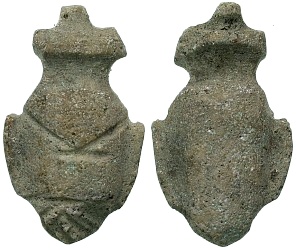

King Tut -- Egyptian Green Basalt Heart Amulet, New Kingdom, c. 1570 - 1070 B.C.
The heart was considered the seat of the power of life. It was guarded after death with special care, mummified separately and, along with the lungs, preserved in a separate jar placed under the protection of the god Tuamutef.
Many pharaohs actually had two tombs, one for the mummy, and another, usually connected underground through a series of tunnels, containing the canopic jars with the internal organs.
A green stone scarab was laid in the breast of the mummy, where the heart used to be; this amulet would perform for him the "opening of the mouth," essential to passing into the World of the Afterlife.
Serpentine basalt is a copper ore. Under a microscope, copper sulphates are clearly visible in the deepest recesses. It had a greener tinge when first cut, but most of the green copper on the surface has been removed by thousands of years of exposure to arsenides and tellurides in the soil -- this effect is impossible to duplicate or counterfeit successfully, which is why the patination should never be disturbed.
The shape is that of the urn which contained the heart, and which is seen in representations of the Weighing of the Heart against a feather; small vials with the tears of mourners were added to the counterweight to help the soul to pass the test.
cf. Petrie Amulets 7h3; 2.5 mm (1") high; serpentine basalt. This was a part of daily life and death in the New Kingdom of Akhenaten, Nefertiti, Princess Meryt-Aten and her brother who became the Boy King, Tutankamen.
Many people have seen this object on display; few recognized its significance and historical importance. Yet it is most valuable as an aid to Soul-Retrieval in today's world. Use this with your SuperBeacon to reconnect with this past life.
$350.00
31290q00.jpg